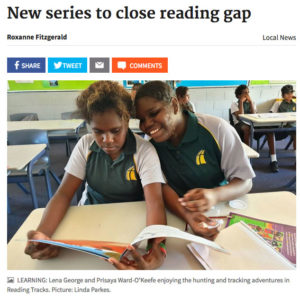The Katherine Times covers Reading Tracks
Roxanne Fitzgerald from the Katherine Times reported recently on Reading Tracks.
Full article here: New Series to Close The Reading Gap
Roxanne Fitzgerald
October 29 2018
A new series of 22 books aimed at older, Indigenous students are helping to ‘close the gap’ when it comes to encouraging teenagers who are behind their peers in print literacy, into reading.
Margaret James, author of Reading Tracks said the books were developed following requests from Elders to create stories featuring the ancient cultures and practices of food gathering.
“The 15 learn-to-read books and seven storybooks, were developed to help engage those students who are substantially below their peers in functional literacy,” Ms James said.
More reading: CWA releases new book documenting history of women in NT and Katherine
“They have been developed to evolve from the ground up to provide levelled fiction and non-fiction texts ranging progressively from emergent levels to age 12 for Indigenous middle schoolers and older. They have also been developed to be interesting, engaging, culturally relevant and informative.”
The former lecturer in Indigenous Tertiary Education at Batchelor University in the NT, enlisted the help of middle and high school students in several schools in the NT.
“Students from Marrara College were involved at the beginning of the project to give their input as to what stories they would like to see developed,” Ms James said.
“Illustrations in the series were carried out by students at Tiwi College, Melville Island. Elders and students were also involved in the production processes for the books.”
To ensure authenticity in the books Ms James accepted an invitation to go out ‘bush’ with Elders and families to fish for barramundi, track and hunt for emus and dig for witchetty grubs and honey ants.
“We burrowed for goannas in freezing winds in the Gibson Desert winter, looking for signs of witchetty grubs hidden deep in the roots of witchetty trees in Central Australian temperatures in the high 40s, and dug waist high for a tiny sip of honey from an ochre-coloured honey ant in the Western MacDonnell ranges,” Ms James said.
“Aboriginal language words are included in the dialogue to keep the characters authentic, and to draw attention to the ancient languages still spoken in Australia.
“Colloquial standard english is used in the narrative to make it accessible to readers who speak english as an additional language, or dialect,” Ms James said.
Ms James said the proactive involvement of Elders provided a positive message to young adults that the Reading Tracks texts and the work to develop them is important and respected.
“I hope the book encourages the families and community members to support these young adults to attend school, to participate in their learning, and to help preserve and maintain their lifeways through accurate depictions of their cultural knowledge,” Ms James said.
“What a privilege it was, working with Elders, students, communities and teachers on a project we all feel passionate about. Helping teenagers acquire print literacy skills through a two-way approach.” she said.
From concept to print Reading Tracks took three years to develop.

